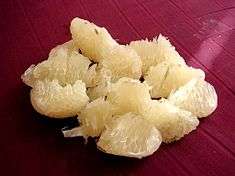Pomelo
Citrus maxima (or Citrus grandis), (Common names: pomelo, pomello, pummelo, pommelo, pamplemousse, jabong (Hawaii), shaddick,[1] or shaddock) is a natural (non-hybrid) citrus fruit, with the appearance of a big grapefruit, native to South and Southeast Asia.
Etymology
_Merr.)%3B_flowe_Wellcome_V0042686.jpg)
Citrus maxima was originally called "shaddick" in English, after the captain of an East India Company ship who introduced it to Jamaica in 1696.[2] The word "pomelo" has become the more common name, although "pomelo" has historically been used for grapefruit. (The 1973 printing of the American Heritage Dictionary, for example, gives grapefruit as the only meaning of "pomelo".)
The etymology of the word "pomelo" is complex. In Tamil language common in many regions where wild and cultivated pomelo still growth it is called pampa "limāsu", which means big citrus. The name was adopted by portugees as "pomposos limões" and distributed further on by Dutch as "pompelmoes". In some provinces of Belgium the grapefruit will also be called pompelmoes, which may cause confusion. The name can be find with some deviations in many european languages, for example German (Pampelmuse), Latvian (Pampelmūze), Ido (Pompelmuso), whereas some other languages use "pomelo" (Turkish, Norwegian, Polish). This fruit is often called by "shedock" whereby English authors like to assign it to the name of a British captain, however, such a theory would not comply with another name of pomelo in much older languages like "jeruk bali" in Indonesian and "chadek" in Kreyòl languages. It would be logical to accept the asian origin of the name, as it is growing there till now and never grew in England, however, British launched recently another theory and proposed that "pomelo" is an alteration of a compound of English names pome ("apple") + melon.[3] Citrus maxima is native to Southeast Asia[4] where it is known under a wide variety of names. In large parts of South East Asia, it is a popular dessert, often eaten raw sprinkled with, or dipped in, a salt mixture. It is also eaten in salads and drinks.
Description and uses
_005.jpg)
It is usually pale green to yellow when ripe, with sweet white (or, more rarely, pink or red) flesh and very thick albedo (rind pith). It is a large citrus fruit, 15–25 centimetres (5.9–9.8 in) in diameter,[5] usually weighing 1–2 kilograms (2.2–4.4 lb). Leaf petioles are distinctly winged.
The fruit tastes like a sweet, mild grapefruit (which is itself believed to be a hybrid of Citrus maxima and the orange[6]), though the typical pomelo is much larger than the grapefruit. It has none, or very little, of the common grapefruit's bitterness, but the enveloping membranous material around the segments is bitter, considered inedible, and thus is usually discarded. The peel is sometimes used to make marmalade, can be candied, and is sometimes dipped in chocolate. In Brazil, the thick skin is often used for making a sweet conserve, while the spongy pith of the rind is discarded. In Sri Lanka, it is often eaten as a dessert, either raw or sprinkled with sugar. Occasionally some Asian fat-heavy dishes use sliced pre-soaked pith to absorb the sauce and fat for eating. Citrus maxima is usually grafted onto other citrus rootstocks but can be grown from seed, provided the seeds are not allowed to dry out before planting.
The fruit is said to have been introduced to Japan by a Cantonese captain in the An'ei era (1772–1781).[7] There are two varieties: a sweet kind with white flesh and a sour kind with pinkish flesh, the latter more likely to be used as an altar decoration than actually eaten. Pomelos are often eaten in Asia during the mid-autumn festival or mooncake festival.
It is one of the ingredients of "Forbidden Fruit", a liqueur dating back to the early 20th century that also contains honey and brandy. This liqueur is most famously used in the Dorchester cocktail.
Drug interactions
Some medicines may interact dangerously with pomelos and some pomelo hybrids, including grapefruit, some limes, and some oranges.[8]
Varieties
Non-hybrid pomelos
Possible non-hybrid pomelos
Hybrids
The pomelo is one of the four original citrus species (the others being citron, mandarin, and papeda), from which the rest of cultivated citrus hybridized. In particular, the common orange and the grapefruit are assumed to be natural occurring hybrids between the pomelo and the mandarin, with the pomelo providing the bigger size and greater firmness.
The pomelo is also employed today in artificial breeding programs:
- The common sweet orange (Citrus × sinensis) is a pomelo × mandarin hybrid
- The bitter orange (Citrus × aurantium) is another pomelo × mandarin hybrid
- The tangelo is any hybrid between Citrus maxima and a tangerine. It generally has a thicker skin than a tangerine and is less sweet.
- 'K–Early' ('Sunrise Tangelo')[9]
- Grapefruit is a pomelo backcross: pummelo × sweet orange (see above). The grapefruit is itself a parent to many hybrids:
- 'Minneola': Bowen grapefruit × Dancy tangerine[9]
- 'Orlando' (formerly Take'): Bowen grapefruit × Dancy tangerine(pollen parent)[9]
- 'Nova': Clementine × Orlando tangelo cross[9]
- 'Seminole': Bowen grapefruit × Dancy tangerine[9]
- 'Thornton': tangerine × grapefruit, unspecified[9]
- 'Ugli': mandarine × grapefruit, probable (wild seedling)[9]
- The Oroblanco and Melogold grapefruits are hybrids between Citrus maxima and the grapefruit.
- Mandelos: pomelo × mandarine (Citrus maxima).
- Hyuganatsu is a pomelo hybrid
Gallery
-
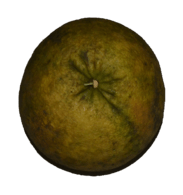
Whole ripe pomelo from Kerala (South India)
-

South Indian pomelo cut in half
-

Sectioned pomelo
-
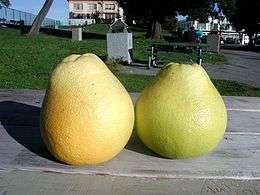
Pomelos
-

Pomelo after being cut
-

Sectioned pomelo
-
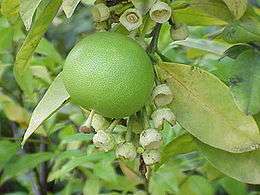
Pomelo on tree, has fruit and blossoms in the same time
-
Ipoh pomelos on sale at Chinatown, Singapore
-
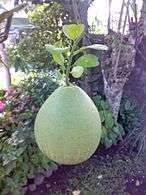
Fruit on tree; Philippines
-
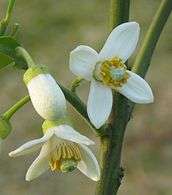
Pomelo flower in early April
-
_004.jpg)
Pomelo blossom
-
_001.jpg)
Cluster of blossoms
-
Yam som-o: spicy Thai pomelo salad with tamarind juice
-
Tam som-o nam pu: spicy Thai pomelo salad with crab extract
-
Fujian's Pinghe County is famous in China for its pomelos
-

Pink pomelo
-
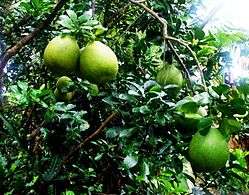
Pomelo in southern Vietnam.
-

As a kitchen fruit
-

In growth
-

Pomelo in growth
-
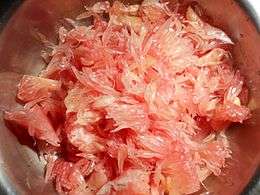
-

Pomelo orchard
-
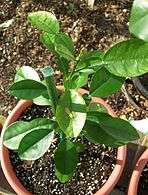
Pomelo seedling
-

Tree
-
Top view of 'Honey' cultivar
-
Side view of 'Honey' cultivar
References
- ↑ "Shaddick". Britannica Online. Encyclopedia Britannica, Inc. Retrieved 13 January 2013.
- ↑ American Heritage Dictionary, 1973.
- ↑ “pomelo, n.” listed in the Oxford English Dictionary [Draft revision; June 2008]
- ↑ "Pummelo". Hort.purdue.edu. Retrieved 2012-01-07.
- ↑ Growing the granddaddy of grapefruit, SFGate.com, December 25, 2004
- ↑ Grapefruit "Grapefruit" Check
|url=value (help). Hort.purdue.edu. Retrieved 2012-05-12. - ↑ "阿久根市: 観光・特産品(ボンタン)". City.akune.kagoshima.jp. Retrieved 2012-01-07.
- ↑ Grapefruit–medication interactions: Forbidden fruit or avoidable consequences? CMAJ March 5, 2013 vol. 185 no. 4 First published November 26, 2012, doi: 10.1503/cmaj.120951 David G. Bailey, George Dresser, J. Malcolm O. Arnold,
- 1 2 3 4 5 6 7 Morton, J. 1987. Tangelo. p. 158–160. In: Fruits of warm climates. Julia F. Morton, Miami, FL. http://www.hort.purdue.edu/newcrop/morton/tangelo.html
External links
- Pomelo Nutrition Information from USDA SR 22 database
- Pomelo: The "lucky" giant citrus

